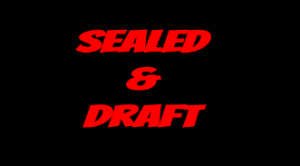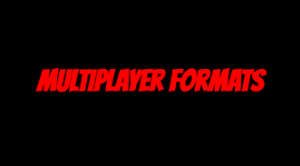All MTG Formats Explained - What They Are And How They Work
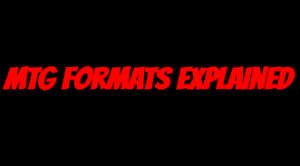
One thing that makes Magic: The Gathering so great is its different formats. There are quite a few and each one changes how you'll play the game. This gives players the freedom to explore and experience the game in the way they like best. As well as, keeps things fresh for long-time players and helps ensure that your cards always have a place they can be played.
While MTG's multitude of different formats is nice, it can also be confusing and intimidating to new players. After all, the rules and what cards you're allowed to use can will change to some degree in almost every format. So, it can be quite a lot to digest if you're new to the game or you're jumping into a format you've never played before. If you're one such person, worry not. Today I'll be breaking down all of the MTG formats that you need to know and how they work.
So, without further ado, let's jump right in.
What Are Formats And What Are They For?
Let's start at the beginning. A format is a name for a set of rules that dictates how you'll play the game of Magic. Examples of things formats can change include: How many cards you can have in your deck, how many opponents you'll play against, how much life you have, which cards you can use, and even how you build decks.
Having a name for each of these rule sets and game variations makes it easy for players to know what rule set they're playing under, what cards they're allowed to use, and what they are/aren't allowed to be doing. Hopefully, this helps to make the concept of formats, in general, a little clearer.
Constructed Vs Limited
These terms will come up quite a few times when talking about different formats, so let's get what they mean out of the way now.
Constructed: Refers to any format where players build or "construct" their decks before showing up to play. In these formats, players are allowed to use any card, so long as it is legal in the given format.
Limited: Limited refers to formats where players build decks on the spot using cards from Booster Packs they've opened and then play games with the decks built from these "Limited" card pools.
Limited Formats
General Rules For Limited
- Players build decks out of the cards opened from their packs
- Decks must be at least 40-cards (including basic lands)
- You may add any number of basic lands to your deck
- 1v1 games
- Players start with 20 life
Sealed
In Sealed, players will receive what's known as a "Prerelease Pack" which will contain six unopened Booster Packs of the newest set. Then create a minimum of a 40-card deck using only cards from inside their packs. However, you may add any number of basic lands. The basic lands can be added after deck construction and don't have to have been inside your packs.
Once the decks are constructed, players play 1v1 games starting with 20 life. These games can be best-of-one or best-of-three. Limited is great fun because you get to test your deck-building skills and only have to worry about a very small card pool. What's more, the decks you build and the games you play will be different every time. Lastly, you get to take all your cards (minus the basic lands) home with you after playing. This makes it a great way to build up an MTG collection for newer players.
You May Also Like: The Best Phyrexia: All Will Be One Bombs in Limited
Booster Draft
Booster Draft also has you build a deck on the spot with cards from packs you've opened but it does so in a different way. For Draft, players (usually eight) sit in a circle and each player opens a Booster Pack and chooses one card, without showing it to anyone. Then they pass their remaining cards to the person to their left and choose another card from the cards they received from the player on their right.
This process continues until all cards from these first packs are chosen by players. After that, players open a second pack and repeat the process but this time the packs are passed to the right. Once again, once the second pack is fully drafted, a third and final pack is opened and the rotation goes back to the left.
When all packs/cards have been drafted, each player will build a 40-card deck from the cards they drafted and then play 1v1 games. What makes drafting an interesting experience is that not only do you have a limited card pool but you choose it one card at a time. So, it requires you to constantly be adapting and thinking on the fly in terms of deck-building.
Constructed Single Player Formats
With the Limited formats out of the way, let's look at Constructed formats. In each of these, you'll build a deck before it's time to start playing, using any cards legal in the given format.
General Rules For Formats In This Category
- 2 players (1v1)
- 60-card decks (and an optional 15-card sideboard) using cards legal in that format
- Up to four copies (unless a card is restricted to one copy) of a single card (Aside from Basic Lands)
- Players start with 20 life
- No free mulligan*
- Whichever player goes first doesn't draw a card
*To elaborate some, if you don't have a good opening hand you can take a mulligan by shuffling your hand into your deck and drawing seven new cards. Then you return a card of your choice from your new hand to the bottom of your library for each mulligan you've taken. So, one card on your first, two cards after your second, and so on and so forth.
Standard
Standard is a great place to start playing Magic. In Standard, you'll build a minimum of a 60-card deck (and an optional 15-card sideboard) using cards from the most recent MTG sets. Games can be best-of-one (BO1 Standard) or best-two-out-of-three (BO3 Standard) and are played 1v1. So, with you and one more player. Whichever player goes first will not draw a card on the first turn.
Standard also has a feature called "rotation." As mentioned, the format only uses cards from the latest sets. Whenever a new set is released, it comes into Standard and any cards in that set are "Standard Legal" and can be used in your deck. However, to keep the card pool (cards available to use) from getting too big, once per year when the Fall set releases, the four oldest sets in Standard "rotate out" and can no longer be used.
You May Also Like: 5 Tasty Toxic Standard Decks, Figuratively and Literally
This ensures that the format is always fresh and keeps the card pool small. A smaller card pool creates unique deck-building situations and makes it easier for new players to get a feel for all the cards at their disposal.
Here's a list of what is currently legal in Standard: The Brothers' War, Dominaria United, Streets of New Capenna, Kamigawa: Neon Dynasty, Innistrad: Crimson Vow, and Innistrad: Midnight Hunt.
Standard Specific Rules
- Uses cards from the most recent sets
- When the Fall set is released the four oldest sets "rotate out" and can no longer be used
Pioneer, Modern, Vintage, & Legacy
Pioneer, Modern, Vintage, and Legacy all have very similar rules so I've grouped them together. Each one is a non-rotating format that uses the general rules mentioned above - The only real differences between the four are the size of the card pools.
- Pioneer: Allows players to build with cards from Return to Ravnica forward.
- Modern: Allows players to build with cards from eighth edition forward.
- Legacy: Uses all sets, with the exception of special expansions and sets.
- Vintage: Has the largest card pool of all and uses all cards in print special expansions and sets. Furthermore, there is a "Restricted" list in Vintage that limits certain cards to a single copy.
The larger the card pool a format has, the more powerful the format is. That said, Legacy and Vintage have access to more powerful cards than Modern and Pioneer. So, if you're looking for somewhere to start playing I suggest Pioneer and/or Modern.
Vintage and Legacy have extremely powerful decks that can be a blast to play once you understand the game. The only downside is that these formats use some of the game's oldest cards and as a result playing in paper can get quite expensive.
Pauper
Pauper is a very unique and very fun way to play Magic: The Gathering. It has all the same general rules as the formats mentioned above, 60-card decks, 1v1 games, 20 life, and four copies of each card. However, players are only able to use cards that have been printed at the common rarity. To be clear, if a card has ever been printed at common, it can be used, even if it was later reprinted at a higher rarity.
How To Tell If A Card Is Common?
Common cards will have either a black or white expansion symbol. An example of each can be seen below. Searching for a card using the "format" filter on gather.wizards and scryfall is a surefire way to find Pauper legal cards.
Multiplayer Formats
Each of the formats listed below is non-rotating and is usually constructed and features multiple opponents.
Commander / EDH
Key Takeaways
- 4 players
- 100-card decks built around a Legendary creature
- Each colored card must be within the colors as your Commander
- No more than one copy of each card (Aside from Basic Lands)
- Players start with 40 life
- One free mulligan
- The starting player draws a card on the first turn
- Any card is legal as long as it's not banned
Commander is Magic: The Gathering's most popular format. in Commander, players build 100-card decks around a Legendary creature and play against three other players. Unlike Standard, players may use any card, from any set, so long as it's not banned in Commander and it is within the colors of their Commander. Furthermore, players can only have a single copy of each card in their deck, aside from basic lands. Let's break some of these rules down in more detail.
The Commander
Every EDH deck is built around a Legendary creature or a Planeswalker that specifies that it can be your Commander. The commander will start the game outside of your deck in an area called "The Command Zone", which is usually above your deck. Think of this card as being in your hand at all times. So, whenever it's your turn and you have the mana to cast your Commander, you may do so. This means that you'll want to build your deck around that creature's abilities.
You May Also Like: The Best Phyrexia: All Will Be One Commanders For Each Color
If a player is dealt 21 damage by another player's Commander, they lose the game. This is known as "Commander Damage" and it is tracked across all zone changes. For example, if one player takes control of another player's commander, any damage that Commander has already dealt will remain in place.
Color Identity
In Commander, players may only include cards in their deck that are within their Commander's colors. So, if you've chosen Teneb, the Harvester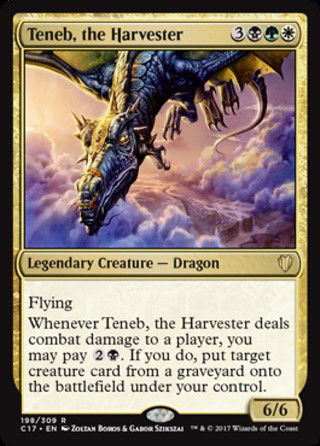 as your Commander your deck could only include cards with White, Black, and/or Green mana symbols and colorless spells.
as your Commander your deck could only include cards with White, Black, and/or Green mana symbols and colorless spells.
Or in other words, the cards in your deck may not contain any mana symbols outside of those colors, regardless of where they appear on the card. As an example, someone playing Teneb, the Harvester could not have Fire Diamond
could not have Fire Diamond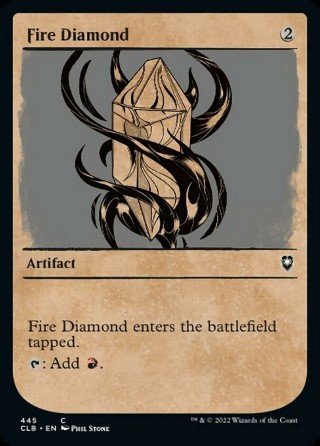 in their deck, since it contains Red.
in their deck, since it contains Red.
The Command Zone
Once you cast them from the Command Zone, it's just like you cast them from your hand. This means they can be countered when being cast from the Command Zone and can attack, block, and be removed just like any other card. Furthermore, anytime they would change zones (meaning go to your hand, the graveyard, or into exile) you may return them to the Command Zone instead and cast them again later.
However, there is a catch. Each time you cast them from the Command Zone beyond the first, they will cost an additional two mana. For example, the first time you cast Teneb, the Harvester , it will cost the four-mana printed on the card. If it is killed and returned to the Command Zone, the next time you cast it you'd have to pay six mana total. This is known as "Commander Tax" and the additional mana can be played with any color of mana.
, it will cost the four-mana printed on the card. If it is killed and returned to the Command Zone, the next time you cast it you'd have to pay six mana total. This is known as "Commander Tax" and the additional mana can be played with any color of mana.
Multiplayer Gameplay
As mentioned, Commander is usually played with four players. Players are positioned around the table randomly and after the first turn, turn progression moves clockwise with players taking their turn one at a time. On your turn, you can attack any player you wish or even multiple players. The same goes for using other effects, permanents, and spells - So long as the player is a legal target for the spell, you can use it on whoever you like.
When a player reaches zero life, that player is out of the game and the remaining players continue to play until only one player is left.
1v1 Commander
EDH is sometimes played 1v1 instead of in a multiplayer setting. When the format is played like this, the core rules stay the same. The only thing that changes is that players will start the game with 30 life, instead of 40. All deck-building restrictions Commander rules and color identity still apply.
Brawl
Brawl can be thought of as "Standard Commander." It uses all of the Commander rules mentioned above, but you can only use cards currently legal in Standard. - With the exception of Arcane Signet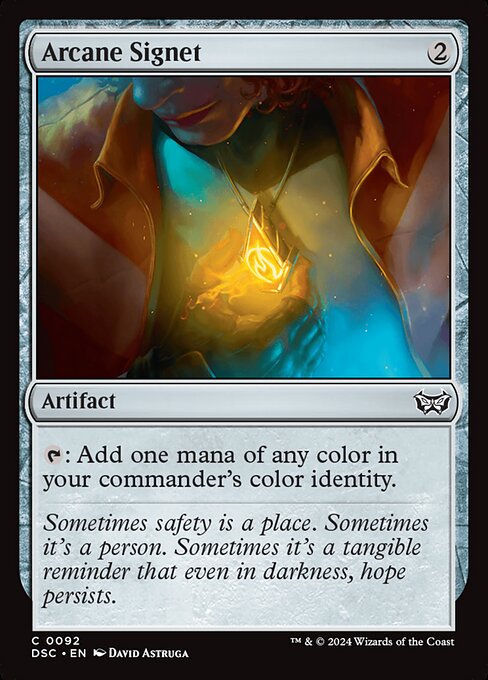 and Command Tower
and Command Tower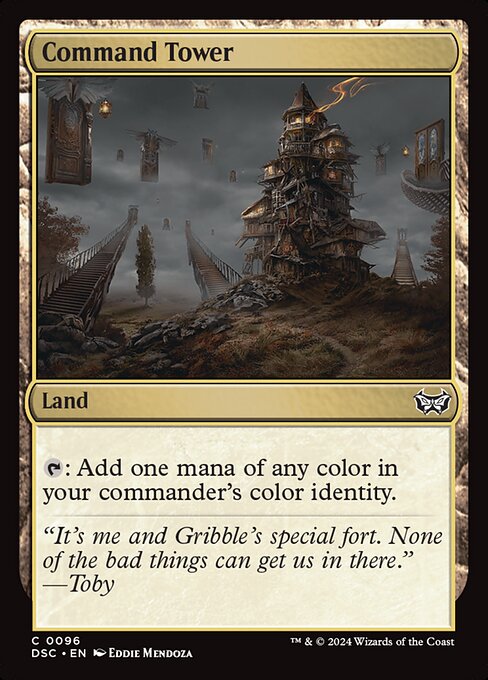 , which are perpetually legal. Other than that, the only differences are:
, which are perpetually legal. Other than that, the only differences are:
- You can use regular Planeswalkers as your commander
- Decks are 60-cards instead of 100
- Players have 30 life instead of 40
You May Also Like: MTG Brawl - Format Guide - Rules And Deck Building Explained
Two-Headed Giant
Two-Headed Giant allows you to play any format mentioned above with a partner. Each player will have their own deck but will strategize, battle, and take their turns simultaneously, as a team. Each team shares 30 life. Other than life, each player uses their own resources. For example, a player could not use their partner's lands to cast a spell. Furthermore, any spell that references "you" applies to only the one casting the spell. For example, Opt would not draw both players on the team a card.
would not draw both players on the team a card.
On the other hand, cards that say "each opponent" or "each player" will affect both players on a team. As an example, Plaguecrafter would cause all players to sacrifice a creature or planeswalker, not each team. As far as goes, either player on a team may use their creatures to block anything attacking their team or a planeswalker the team controls.
would cause all players to sacrifice a creature or planeswalker, not each team. As far as goes, either player on a team may use their creatures to block anything attacking their team or a planeswalker the team controls.
Two-Headed Giant can be played in any of the formats mentioned above. So, you'll adhere to the rules for whichever format you're playing as a team. To elaborate, if you're playing Standard, use only Standard-legal cards. If you're playing Pauper use only common cards. If you're playing Commander, all Commander rules mentioned above apply.
Furthermore, you can do team Booster Draft and Sealed deck as well. Simply apply the team rules mentioned here to the Limited rules mentioned above for the given format.
Magic: The Gathering Arena Formats
Magic Arena is an app where players can play Standard and a few other formats, online. If you've made it this far in the article, they will look pretty familiar to you. Let's jump in.
Explorer
Explorer is a non-rotating format that can be described as an MTGA version of Pioneer. The digital format has more-or-less the same card pool but there are a few key differences. Not all cards from all Pioneer-legal sets are Explorer-legal. The cards within the later sets are only legal if they were released digitally on MTGA. You can find a full rundown of this here.
Historic
Historic is a non-rotating, constructed format that exists only as a digital format. Sets from Ixalan onward are available for players to use. That said, cards from older sets are added to the card pool at WOTC's discretion, and "digital-only" and rebalanced versions of paper cards are also featured.
Historic is unlike any other format, given that older cards can be peppered into the card pool as Wizards sees fit. If you are looking for a fresh way to play the game online, this is a great option.
Alchemy
Alchemy is very similar to Standard. It uses the Standard card pool but also uses new digital cards and rebalanced versions of other cards to create a unique, ever-changing experience for MTGA players.
Conclusion
The plethora of formats in Magic is something very unique as far as I know. Other TCGs usually have some equivalent to Standard where cards rotate out and Extended formats where they don't. However, MTG is the only game I've seen with formats like Draft, Sealed, and Commander that truly give players a different way to play the game.
While having such variety is amazing, the formats can be quite a lot to delve into for inexperienced players. Hopefully, today's article has been helpful in making them easier to understand if you're one such person. With all the MTG formats explained, the only thing to do is to get out there and try them out.

